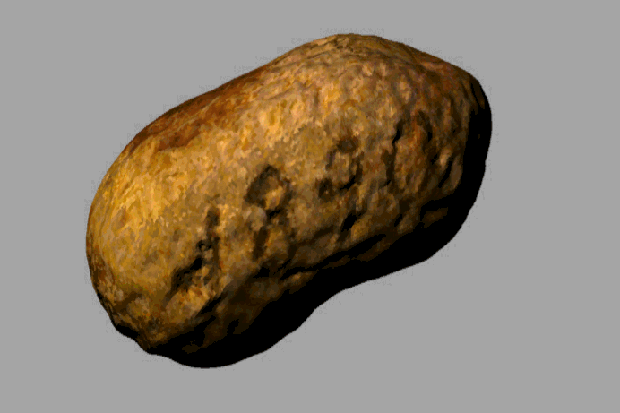
<br>Photo courtesy Isle of Wight County Museum
Dec. 11, 2015
VCU professor 3-D scans world’s oldest ham, peanut
Share this story
Bernard Means, Ph.D, an anthropology professor in the Virginia Commonwealth University School of World Studies who specializes in 3-D scanning archaeological artifacts, visited the Isle of Wight County Museum in Smithfield, Virginia, this week to 3-D scan two unusual artifacts.
How could one resist 3-D scanning the world’s oldest ham and world’s oldest peanut?
“How could one resist 3-D scanning the world’s oldest ham and world’s oldest peanut?” said Means, a faculty member in the College of Humanities and Sciences. “I decided that this would be a fun thing to do, especially as we go into the end of the semester.”
The ham and peanut are part of the museum’s collection, which also features prehistoric fossils, a snake oil medicine box, a turn-of-the-century country store and artifacts from the Smithfield Ham industry. The most notable piece in the collection, however, is the ham, which dates back to 1902 and has been featured in “Ripley’s Believe It or Not!” in 1929, 1932 and 2003.
“P.D. Gwaltney Jr.’s famous pet ham currently resides at the Isle of Wight County Museum. In 1902, a cured ham was overlooked, and for 20 years, the ham hung from a rafter in one of his packing houses,” the museum’s website states. “By 1924, the pet ham was kept in an iron safe which was opened daily for guests to view. Advertised as the world’s oldest Smithfield ham, Gwaltney fashioned a brass collar for the ham and took it to shows and expos to exhibit the preservative powers of his smoking method.”
The ham, which can be viewed 24/7 via the museum’s “Ham Cam,” looks as if it could have been cured this year, Means said.
“It did have a powerful scent that I cannot describe,” he added.
The museum invited Means to visit and scan the artifacts after curator Tracey Neikirk attended a lecture that Means gave on 3-D scanning and printing at an “Archaeology in Action” workshop sponsored by the Virginia Association of Museums.
“She was excited to bring him here to scan some of the items in our collection,” said Jennifer England, the museum’s director. “Not only will we have more documentation on the ham and peanut, but if those items change over time (by nature), we’ll know. We can also replicate some items as hands-on teaching tools.”

England said the museum plans to post the 3-D images on its website and social media accounts, and may create a 3-D-printed version of the ham.
“We would love a 3-D printing of the ham to use as a teaching tool or for other programming,” she said. “Since guests can’t touch the ham and other artifacts now, they’d be able to get a little closer [and] examine it. This [would give] guests a better experience at the museum. Since the world’s oldest ham is one of our main attractions, anything we can do to get folks to be more involved and more excited about the museum is always wonderful.”
Means is the director of the Virtual Curation Laboratory, which 3-D scans and prints archaeological objects, and which aims to tell stories and teach people about heritage through the use of replicas of objects, both through 3-D digital models and 3-D digital prints.
“The ham and the peanut are clearly important to the people of Isle of Wight County, and Virginia as well, and the lab is pleased to help them tell the story,” Means said. “But, I can also use the ham scan and peanut scan to teach my students at VCU.”
In the spring semester, Means and his students will be working on a series of exhibits, and the ham and peanut scans will likely be featured among a larger presentation of the human use of animals and plants. Some of these items, he said, will go on display at the VCU Globe building in the spring.
Officials with the Isle of Wight County Museum may also talk with Means’ students remotely about their museum and why the ham and peanut are important cultural artifacts.
“I am happy the Virtual Curation Laboratory gets to work with small museums and help them get their message out to a global and not just local audience,” Means said.

Subscribe to the weekly VCU News email newsletter at http://newsletter.news.vcu.edu/ and receive a selection of stories, videos, photos, news clips and event listings in your inbox every Thursday.
Subscribe to VCU News
Subscribe to VCU News at newsletter.vcu.edu and receive a selection of stories, videos, photos, news clips and event listings in your inbox.









